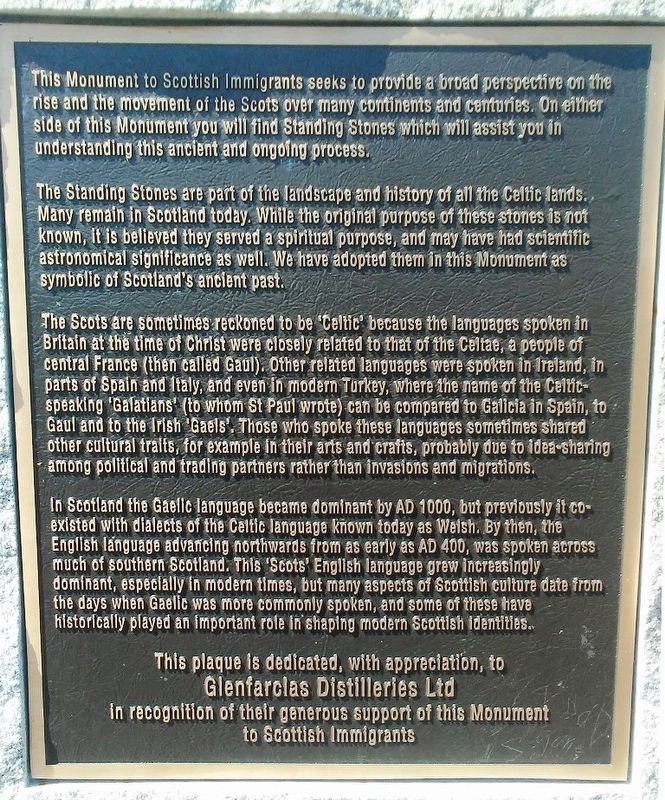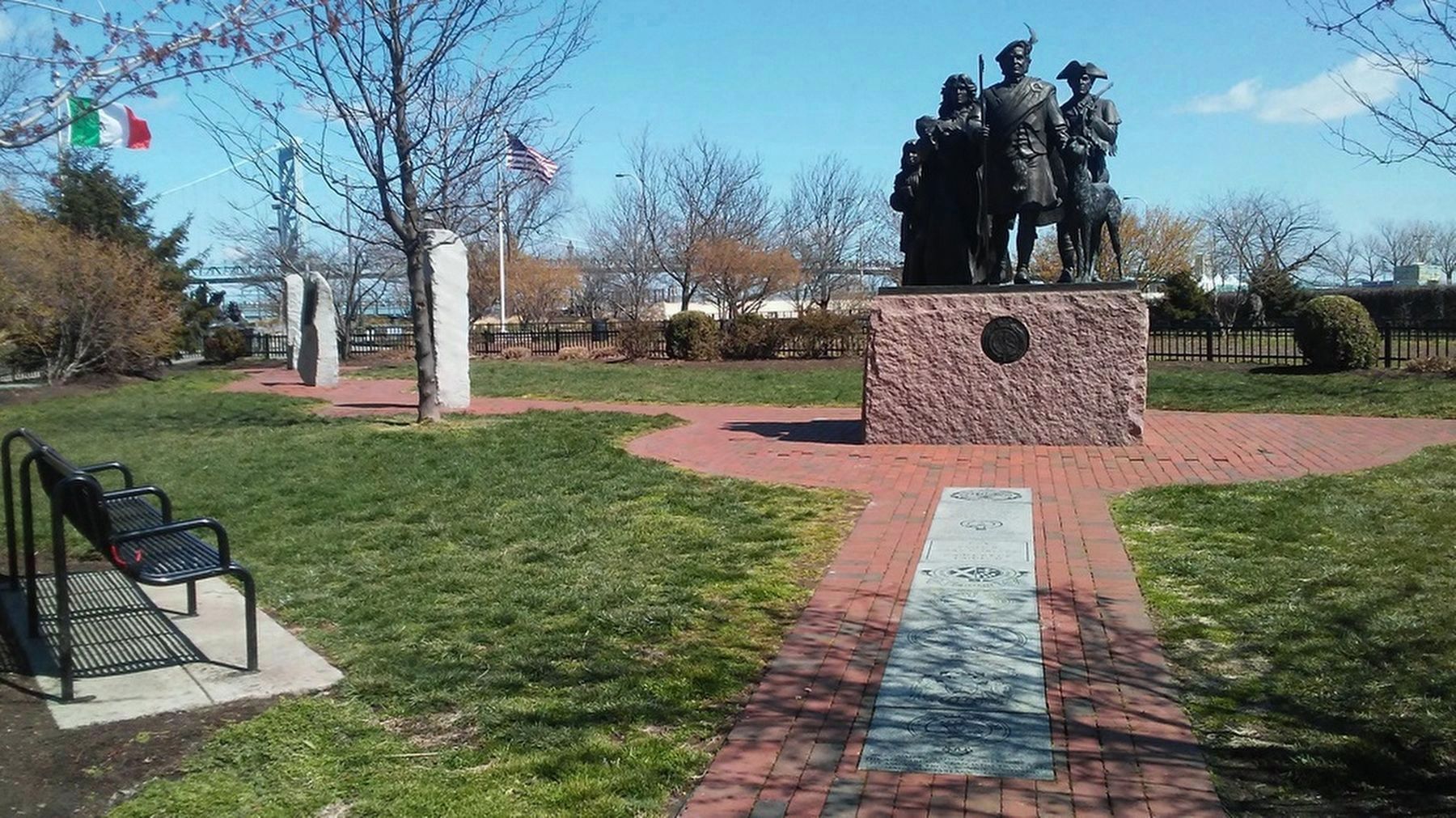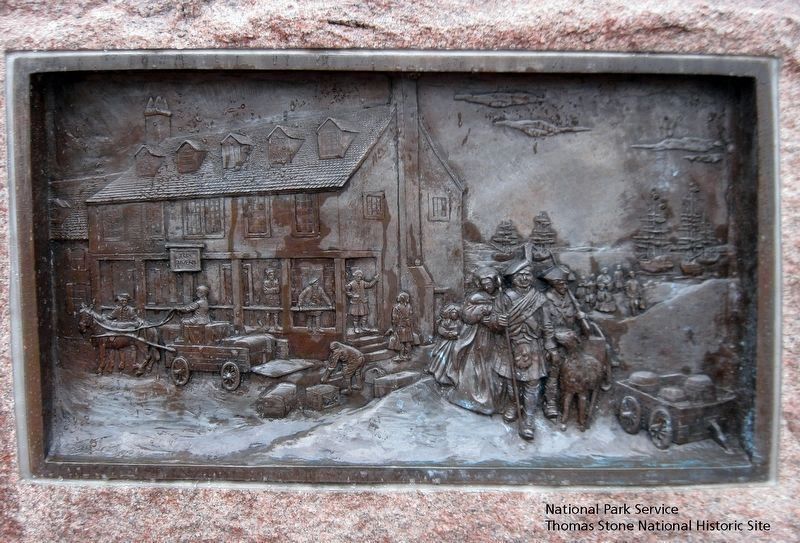Old City in Philadelphia in Philadelphia County, Pennsylvania — The American Northeast (Mid-Atlantic)
Monument to Scottish Immigrants
This Monument to Scottish Immigrants seeks to provide a broad perspective on the rise and the movement of the Scots over many continents and centuries. On either side of this Monument you will find Standing Stones which will assist you in understanding this ancient and ongoing process.
The Standing Stones are part of the landscape and history of all the Celtic lands. Many remain in Scotland today. While the original purpose of these stones is not known, it is believed they served a spiritual purpose, and may have had scientific astronomical significance as well. We have adopted them in this Monument as symbolic of Scotland's ancient past.
The Scots are sometimes reckoned to be 'Celtic' because the languages spoken in Britain at the time of Christ were closely related to that of the Celtae, a people of central France (then called Gaul). Other related languages were spoken in Ireland, in parts of Spain and Italy, and even in modern Turkey, where the name of the Celtic-speaking 'Galatians' (to whom St Paul wrote) can be compared to Galicia in Spain, to Gaul and to the Irish 'Gaels'. Those who spoke these languages sometimes shared other cultural traits, for example in their arts and crafts, probably due to idea-sharing among political and trading partners rather than invasions and migrations.
In Scotland the Gaelic language became dominant by AD 1000, but previously it co-existed with dialects of the Celtic language known today as Welsh. By then, the English language advancing northwards from as early as AD 400, was spoken across much of southern Scotland. This 'Scots' English language grew increasingly dominant, especially in modern times, but many aspects of Scottish culture date from the days when Gaelic was more commonly spoken, and some of these have historically played an important role in shaping modern Scottish identities.
Glenfarclas Distilleries Ltd
in recognition of their generous support of this
Monument to Scottish Immigrants
Erected 2011 by Concerned Citizens and Organizations.
Topics. This historical marker is listed in these topic lists: Fraternal or Sororal Organizations • Patriots & Patriotism • Settlements & Settlers.
Location. 39° 56.84′ N, 75° 8.531′ W. Marker is in Philadelphia, Pennsylvania, in Philadelphia County. It is in Old City. Marker is on Front Street south of Ionic Street, on the left when traveling south. Touch for map. Marker is in this post office area: Philadelphia PA 19106, United States of America. Touch for directions.
Other nearby markers. At least 8 other markers are within walking distance of this marker. Courage of the Scottish Immigrants (here, next to this
marker); a different marker also named Monument to Scottish Immigrants (here, next to this marker); St. Andrew's Society of Philadelphia (a few steps from this marker); History of Scotland (a few steps from this marker); Tun Tavern (within shouting distance of this marker); Pennsylvania Abolition Society (within shouting distance of this marker); Anthony Morris (within shouting distance of this marker); The Irish Memorial / Leacht Cuimhneacháin na nGael (within shouting distance of this marker). Touch for a list and map of all markers in Philadelphia.
Also see . . .
1. National Monument to Scottish Immigrants. A View on Cities website entry (Submitted on March 27, 2017, by William Fischer, Jr. of Scranton, Pennsylvania.)
2. Scottish Emigration to America. Scottish Ancestors website entry (Submitted on March 27, 2017, by William Fischer, Jr. of Scranton, Pennsylvania.)
3. Philadelphia: Immigrant City. Balch Online Resources website entry (Submitted on March 27, 2017, by William Fischer, Jr. of Scranton, Pennsylvania.)
4. Scottish History. Scotland website homepage (Submitted on March 27, 2017, by William Fischer, Jr. of Scranton, Pennsylvania.)
5. Emigration and passenger lists. National Library of Scotland website entry (Submitted on March 27, 2017, by William Fischer, Jr. of Scranton, Pennsylvania.)
6. A brief history of emigration & immigration in Scotland. John Gray Centre website entry (Submitted on March 27, 2017, by William Fischer, Jr. of Scranton, Pennsylvania.)
Credits. This page was last revised on March 6, 2024. It was originally submitted on March 27, 2017, by William Fischer, Jr. of Scranton, Pennsylvania. This page has been viewed 499 times since then and 66 times this year. Photos: 1, 2. submitted on March 27, 2017, by William Fischer, Jr. of Scranton, Pennsylvania. 3. submitted on August 9, 2019.


